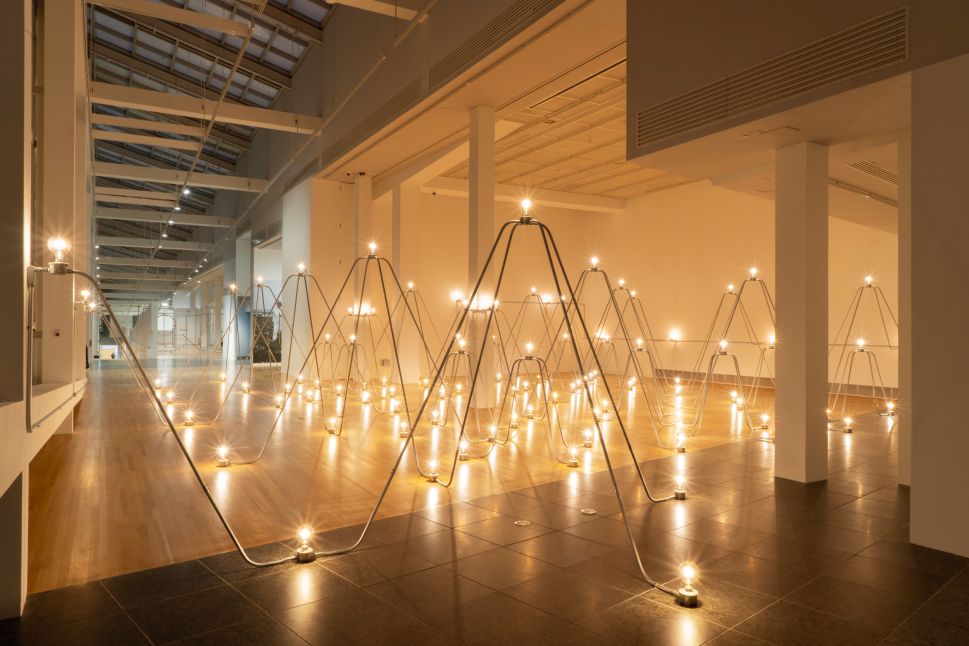Nancy Holt features waves of exposed metal electrical conduit arranged in looping arcs across a gallery floor, each joint topped with glowing incandescent bulbs, creating a grid-like field of light and industrial form.” width=”970″ height=”647″ data-caption=’Nancy Holt, <em>Electrical System</em>, 1982; Steel conduit, lighting and electrical fixtures, light bulbs, electrical wire and electricity, dimensions variable. <span class=”lazyload media-credit”>Courtesy Holt/Smithson Foundation and Sprüth Magers, Los Angeles © Holt/Smithson Foundation</span>’>
Welcome to One Fine Show, where Observer highlights a recently opened exhibition at a museum not in New York City, a place we know and love that already receives plenty of attention.
In my freshman year of college, I had a roommate from California who was terrified of our walls. Our dorm had two rooms, but we had arranged it so the outer room was an area for study and the reception of guests, with all the contemporary tools of entertainment—drinks cart, Aqua Teen Hunger Force DVDs, etc. This meant sharing a bedroom in a looming Georgian structure in New England, which was heated by radiators that clanked and hissed deep within the walls. I assured the Angeleno that all this was normal, but I would see him up at night, uncertain that the building wasn’t trying to kill him.
I thought about my friend while wandering through Nancy Holt’s Hot Water Heat (1984), which is on view in her survey “Power Systems” at the Wexner Center for the Arts, which brings to Ohio the artist’s conceptual sculptures, so rooted in the ancient buildings of the East Coast. I thought of him, too, during the performance I saw on my first night there: “Channeling Greater Power,” led by the artist Maria Hupfield who has a simultaneous exhibition at the Wexner and sought to channel the ghost of Holt (1938-2014) through recordings and an image of her apartment.
SEE ALSO: At Marian Goodman Gallery, Tavares Strachan Investigates the Stories that Shape Our Existence
The recording itemized the materials found in every object of the apartment Holt shared with her husband, Robert Smithson (1938-1973). Never before has so much emerged from a pair of hippies staring at the wall. Hot Water Heat resembles an externalized level from Super Mario; a series of pipes joined in such a mad way that they seem to have their own agency. Were power-up mushrooms involved here, too? Radiators round out the maze, and visitors can turn a crank to control the room’s humidity and temperature, which are recorded and then turned into a drawing.
Holt sought to make networks of energy visible. The masterpiece in this show is Electrical System (1982). This fantastic structure’s radicality begins by placing lightbulbs on the floor and continues by placing others far above, far higher than they would be on most ceilings. Here, too, Holt’s materiality speaks the language of industry, with the sculptures constructed of nothing fancier than the brushed steel conduits that actually do carry electric wires deep within a building. Taken out of the walls, they resemble benevolent multi-limbed creatures, so high up that they must have something to teach us.
Few works not by Dan Flavin have begun so obviously on graph paper, and the wall text beside Holt’s conception for these speaks of ‘exposure,’ but that’s not the feeling one has in the actual work. You are enveloped, enmeshed within the electricity and light. The work has its own arcane logic to it, as well. You have to duck a little and be careful where you step. Any promise of disclosure is a feint.
Holt’s work is “site reflexive” rather than “site specific,” and the Wexner has done an admirable job of integrating her vision into their architecture. Her oil work Pipeline (1986) begins outside the building and snakes down into it, beckoning visitors with a promise of a better relationship to the inhuman elements that meet their human needs.
“Nancy Holt: Power Systems” is on view at the Wexner Center for the Arts through June 29, 2025.

